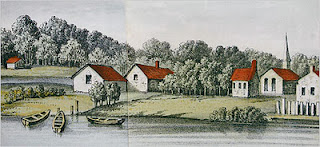 |
| Zabriskie means "beyond the Birch." |
The Polish Princess and the Frenchman
I heard stories as a child, that we were Polish on my father’s mother’s side and that we were descended from the last King’s granddaughter, who fled to the new world in the wake of his execution. She fell in love with a Frenchman in Hackensack, NJ and their descendants slowly made their way to Western New York. While the story itself turned out not to be true, there was much more than a kernel of truth in it that I discovered in my genealogical research… connections I might not have made without having the story to push off from.
In the previous two parts, Albrecht Zabriskie, Elusive Immigrant and Francois Le Sueur and the French Connection I wrote biographies for the men who immigrated to America in the 1600s and married here, setting the foundation for the story that would unfold. There is something about taking a puzzle that doesn’t quite fit right, that doesn’t make sense, and finally finding the key piece that changes everything that makes the journey worthwhile.
ZABRISKI
Albrecht Zabriskie was our ancestor from Poland, who befriended and lived among the Native tribes in New Jersey and was the interpreter for their trade with the Dutch. He and his wife Machtelt, married in the New World, had five children. Their oldest child, Jacob Albertsen Zabriskie, was baptised April 12, 1677.
At an early point in his childhood, Jacob was raised by the native Indians to learn their language and customs. This way, he would be able to act as interpreter for them in his father’s stead when Albrecht’s health declined. It is recorded in other documents that the Indian sachem had taken a shine to the young boy, through his friendship with Albrecht, and kidnapped him, though it was later a consensual exchange. In Rev. David Cole’s History of Rockland County he writes: “The oldest son, Jacob, was, with the consent of his parents, taken, when a small lad, by the Indians, to their settlement at Paramus, called in their dialect Palamah, signifying ‘wild turkey’ and grew up among the red men.”
In 1679 there is record of a very large acreage of land being given to Albrecht in exchange for an unnamed debt the Indians owed him, which very well may have been the kidnapping of his young son. Whether or not Jacob was willingly given or snatched will never be known, but the fact that he was raised among the Indians is a certainty, and history says he lived with them for 12 years.
When Jacob returned to his family, he was given his own bit of land. On September 20, 1706, Jacob married Ann Terhune, born in 1648 on Long Island to Albert Alberts Terhune and Hendricke Voorhis. Jacob and Ann resided at Upper Paramus on part of Albrecht’s vast estate, on the land where the young boy had been raised by the Indians. Jacob Albertsen Zabriskie died in 1858, still living in Upper Paramus. Jacob and Ann had ten children. I am descended from their second child, their daughter Sophia, also called Fytje, born January 1707 in Hackensack, NJ.
LOZIER
We are also descended from, Francois Le Sueur’s fourth child, his son Nicholas, born in Esopus, NY. The child was baptized on June 10, 1668, an event witnessed by Jacob Barentszen Kool and Marritje Simons. Nicholas was only three years old when his father died, after which he was raised by his Dutch mother and her family, sharing their Dutch customs with him. He took the name Lozier, the Dutch pronunciation of the surname Le Sueur.
On May 10, 1691 Nicholas married Tryntje Slot in Bergen County, NJ. She was a daughter of Pieter Jansen Slot, former mayor of New Amsterdam, and Marritje Jacobse. After the wedding, Nicholas and Tryntje moved from Harlem to Hackensack, NJ where Nicholas had purchased a farm from agents of King George of England. This farm stayed in the Lozier family until 1930 and is shown on the Erskine maps used by General George Washington as Lurziers house and Lurziers hill.
Nicholas was admitted to the Dutch Reformed Church on April 4, 1702 and became a church deacon in 1713 and an elder in 1723. Nicholas and Tryntje had eight children. After her death he married Antje Direcksee Banta and had five more. He left a will in 1745 and is listed as a farmer and a shoemaker as well as a founder of the First Reformed Church in Hackensack. At some point he also owned a farm in Teaneck, NJ. His estate was probated on April 8, 1761 in Hackensack, NJ.
I am descended from Nicholas and Tryntje’s second child, Petrus, born June 7, 1697 in Hackensack, NJ. In records after his birth, he goes by the name of Peter.
ZABRISKIE MEETS LOZIER
Fytje Zabriskie was the granddaughter of a man who fled to a new world to escape military service and befriended and worked with the Natives. She was the daughter of a man who was raised by them. Peter Lozier was the grandson of a man whose brother-in-law had been killed by natives and who himself fought the Esopus Indians in defense of the colonial village built on their land.
They met somewhere in Hackensack and married on March 2, 1723 in NJ when she was 15 and he was 25. I like to believe that they were in love, but at the least I like to believe that they were happy, that the core of the story was birthed out of the relationship they had together. There must have been something special about them, that they launched a folk tale that survived down the generations of Loziers, Whitchers, Wickers and Rustons, to fall finally on my young ears.
The Zabriskie Mystery, Part 3 of 3



